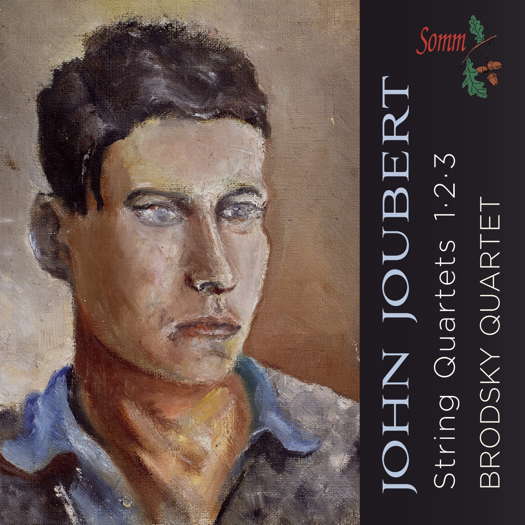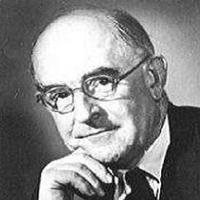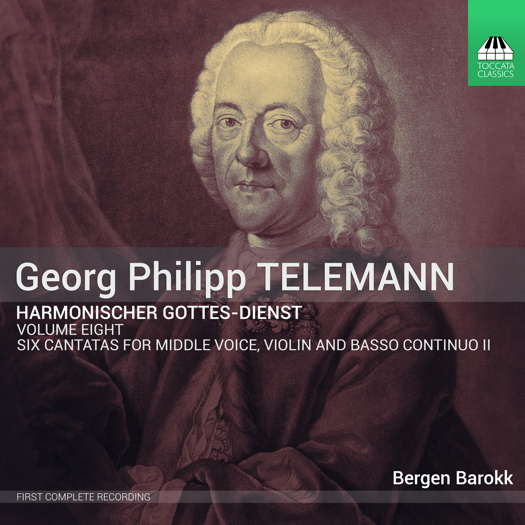 SPONSORED: CD Spotlight. A Fascinating Recording - John Joubert's string quartets, heard by Alice McVeigh.
SPONSORED: CD Spotlight. A Fascinating Recording - John Joubert's string quartets, heard by Alice McVeigh.
All sponsored features >>
- SWR Classic
- Christopher Brown
- Ronald Stevenson
- Danish
- caprino
- Peter Gelb
- Simon Callaghan
- Jessie Ann Richardson
 SPONSORED: Ensemble. Unjustly Neglected - In this specially extended feature, Armstrong Gibbs' re-discovered 'Passion according to St Luke' impresses Roderic Dunnett.
SPONSORED: Ensemble. Unjustly Neglected - In this specially extended feature, Armstrong Gibbs' re-discovered 'Passion according to St Luke' impresses Roderic Dunnett.
All sponsored features >>

Outstanding Virtuosity and Style
GEOFF PEARCE is impressed with Telemann cantatas from Bergen Barokk
'... a very fine result ...'
I have never heard any cantatas by Telemann before, so was curious to hear what this disc had to offer. Georg Philipp Telemann (1681-1767) is a composer who I like very much, but I am only familiar with his instrumental writing. I was surprised to learn that he had written possibly over fifty operas (of which nine survive intact), and 1,043 sacred cantatas. This recording is of six cantatas for middle voice, violin and basso continuo and is Volume 8 in the series of cantatas of the Harmonisscher Gottes-Dienst written between 1725-1726. This comprised a set of seventy-two cantatas, and Volume 8 is the recording for the middle voice and forces mentioned above. The notes that accompany this recording are very comprehensive and give historical information, analytical breakdown and information about the superb performers.
The first cantata in this series, Am sechsten Sonntage nach der heil. Drey Könige: Was ist das Herz?, TWV 1:1516, comprises two recitatives and two da capo arias and uses the violin as an obligato instrument. It opens with a recitative that says basically there is no room for true light in a human heart. This is followed by an aria which is gentle and asks for enlightenment of the human heart to true light. This is followed by a recitative, again speaking of the darkness in the human heart, and the concluding aria illustrates the consequences of not following a path to the light.
Listen — Telemann: Arie (Drey Könige: Was ist das Herz?)
(TOCC 0266 track 4, 0:00-0:50) ℗ 2024 Toccata Classics :
The second cantata, Invocavit (First Sunday in Lent) Fleuch der Lüste Zauberauen, TWV 1:549, comprises an opening da capo aria, followed by a recitative and concluding with another aria. In the first aria, the soul is advised to fight against the false things that tempt it at every turn and not be seduced by false beauty and attractions. The recitative speaks of the conflict between the flesh and the spirit, whilst the final aria concerns a battle which will end in the defeat of the flesh and distress, and the successful combatant will enter into a place of peace and joy.
Listen — Telemann: Arie (Fleuch der Lüste Zauberauen)
(TOCC 0266 track 5, 1:15-1:54) ℗ 2024 Toccata Classics :
The third cantata, Judica: Wer ist, der dort von Edom kömmt?, TWV 1:1584 basically concerns itself with Christ's upcoming sacrifice to save us all. It has the same structure as the first cantata on this recording. The opening recitative depicts God coming from Edom and Bozrah wearing red robes upon which the blood of the people will be scattered. This is followed by an aria which reflects on Christ's upcoming sacrifice. The recitative that follows explains how the blood of Christ will atone for mankind's sins. The final aria says goodnight to the old way of life and welcomes the new which is possible through the blood of Christ.
Listen — Telemann: Arie (Wer ist, der dort von Edom kömmt?)
(TOCC 0266 track 9, 0:00-0:47) ℗ 2024 Toccata Classics :
The structure of Am zweyten Oster-Feyer-Tage: Triumphierender Versöhner, tritt aus einer Kluft Hervor, TWV 1:1422 is an aria, followed by a recitative and a concluding aria. The opening aria is inspired by text from St Peter which says that God's salvation is open to all, both the Jew and the gentile, and the text of this aria encourages Jesus to step forth from the grave. It is upbeat and cheerful. The recitative which follows is longer than the usual and is in two different parts, one mocking Jesus' predicament and the second part saying that the empty grave is proof of Jesus' resurrection. The final aria depicts a dialogue between Christ and the soul, depicting the contrast between grief and joy, doubt and faith.
Listen — Telemann: Arie (Triumphierender Versöhner, tritt aus einer Kluft Hervor)
(TOCC 0266 track 14, 2:51-3:46) ℗ 2024 Toccata Classics :
Misericordias Domini: Hirt' und Bischof uns'rer Seelen, TWV 1:805, is in the same format as the previous cantata. The opening aria is fast and conveys the message that the shepherd's task is to nourish and protect his flock. In the recitative, dew falling on Mount Zion is depicted as God's blessing and encourages everyone to join the heard and shelter in the stable to be able to enter into the promised land, where the final aria describes the pleasure and nourishment.
Listen — Telemann: Arie (Hirt' und Bischof uns'rer Seelen)
(TOCC 0266 track 15, 1:37-2:15) ℗ 2024 Toccata Classics :
The final cantata in this set, Am dritten Pfingst-Feyer-Tage: Ergeuss dich zur Salbung der schmachtenden Seele, TWV 1:448, again using the same format as the previous cantata, conveys a soul weakening and hoping for holy anointment, with the middle part yearning for a holy breeze to nourish the soul. The following recitative warns that even though baptism has given the listener God's blessings, sin could undo all this, so the spirit of man must always try and triumph over the temptations of the flesh. The final aria reinforces this dichotomy but belief in the holy spirit can enjoy life, power, joy and peace.
These are very different from the works of J S Bach in the fact that they are simpler in emotional content, and less reflective and meditative in the arias than in Bach's works. There is generally less sorrow and the works are more cheerful in nature. I think that in the third cantata, the emotional content is in the same direction.
As I said in the opening, the accompanying notes are very informative. The performances from Bergen Barokk here feature the very fine mezzo-soprano Marianne Beate Kielland, who produces a fine pure agile voice, with impeccable phrasing and intonation. The obligato violin parts are played by Bjarte Eike with outstanding virtuosity and style. Markku Luolajan-Mikkol supports on cello, along with Thomas C Boysen on theorbo and Hans Knut Sveen on harpsichord. They collectively deliver a very fine result of music which I suspect is largely unknown, because Telemann has a different approach and totally different feeling than do some of the other sacred music composers of the period.
Copyright © 15 June 2024
Geoff Pearce,
Sydney, Australia



